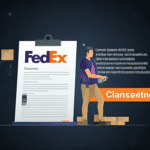Understanding FedEx Package Insurance Rates
If you’re using FedEx to ship packages, you might consider purchasing package insurance to protect your shipment in case of damage, loss, or theft. But what is FedEx Package Insurance, and why is it important? In this article, we’ll take a deep dive into understanding FedEx Package Insurance Rates, how it works, types of insurance available, and tips for reducing its cost. We’ll also address common misconceptions about package insurance and how to file a claim with FedEx Package Insurance if something goes wrong.
What is FedEx Package Insurance and Why is it Important?
FedEx Package Insurance is an optional service that allows you to insure your shipments for up to the declared value. This insurance covers theft, loss, or damage to the package during transit. When you ship a package with FedEx, the carrier assumes limited liability for any loss or damage. FedEx Package Insurance provides the extra protection you need for valuable parcels.
One of the benefits of FedEx Package Insurance is that it offers peace of mind to both the sender and the recipient. If a package is lost or damaged during transit, insurance coverage can help to cover the cost of replacing the item or reimbursing the sender for the declared value of the package. Another advantage is the customization options available to meet specific needs, such as selecting additional options like signature confirmation or special handling instructions.
How FedEx Package Insurance Works
When you use FedEx Package Insurance, you declare the value of your shipment and purchase insurance coverage for that amount. If the package is lost, damaged, or stolen, you can file a claim with FedEx Package Insurance to recover the declared value. If your shipment is worth more than FedEx’s liability limit, you may need to purchase additional insurance to ensure full protection.
It is important to note that FedEx Package Insurance only covers the declared value of the package and does not include any indirect or consequential damages. Additionally, certain items such as jewelry, artwork, and antiques may require additional documentation and appraisal to be eligible for coverage. It is recommended to carefully review the terms and conditions before purchasing to ensure that your shipment is fully protected.
What are the Different Types of FedEx Package Insurance?
FedEx offers two types of package insurance:
- Declared Value Coverage: The standard insurance that FedEx offers with every shipment. You declare the value of your package and purchase insurance coverage for that amount. If the package is lost, damaged, or stolen, you can file a claim to recover the declared value.
- Additional Coverage: An optional service that provides extra protection for high-value shipments. You can purchase additional insurance in increments of $100, up to a maximum of $50,000 per package. This coverage includes areas not covered by the standard declared value coverage, such as damage caused during loading or unloading, and damage caused by mechanical malfunction.
It is important to note that FedEx package insurance does not cover certain items, such as cash, jewelry, and antiques. If you are shipping these types of items, you may need to purchase additional insurance from a third-party provider. Additionally, FedEx may require proof of value for certain items before providing insurance coverage.
How to Determine the Value of Your Shipment for Insurance Purposes
To determine the value of your shipment for insurance purposes, consider the cost of goods, shipping fees, and other expenses incurred. Keep records of your shipment’s value, such as invoices, receipts, or appraisals, to support your claim in case of loss or damage.
Some insurance policies may have limitations on the amount of coverage they provide. Review your policy carefully and consider purchasing additional coverage if necessary. Using a reputable shipping company with a good track record for handling valuable items can also help minimize the risk of damage or loss.
Factors That Affect FedEx Package Insurance Rates
The cost of FedEx Package Insurance varies based on factors including the declared value of the shipment, the shipping destination, and the shipment’s weight and dimensions. The insurance rate is typically a percentage of the declared value of the package. Higher declared values result in higher insurance rates. International shipping may have additional costs due to customs regulations and other factors.
Another factor that can affect the cost of insurance is the type of item being shipped. Some items, such as electronics or fragile items, may require additional insurance coverage. The shipping method chosen can also impact the insurance rate; faster shipping options may have higher rates due to increased risk.
Tips for Reducing FedEx Package Insurance Rates
If you’re looking to reduce your FedEx Package Insurance Rates, consider these strategies:
- Package your shipment well to reduce damage during shipping.
- Ship your package during off-peak hours to avoid peak season fees.
- Use slower delivery options, such as FedEx Ground, to save on shipping and insurance costs.
- Consider raising your deductible to reduce insurance premiums.
- Negotiate with FedEx for a lower rate if you are a frequent shipper.
- Consider using a third-party insurance provider instead of purchasing insurance directly from FedEx.
- Review your shipping history and address any consistent issues of damage or loss to potentially reduce insurance rates over time.
When Should You Consider Purchasing Additional Coverage for Your Shipment?
If your shipment is particularly valuable, you should consider purchasing additional coverage. Standard declared value coverage may not cover the full value of your package.
Consider the fragility of your shipment as well. Delicate or easily breakable items may require additional coverage due to higher susceptibility to damage during transit. Certain items, such as antiques, artwork, or jewelry, may not be covered under standard coverage, making additional insurance crucial.
Common Misconceptions About FedEx Package Insurance Rates
One common misconception is that third-party insurance makes FedEx insurance unnecessary. However, FedEx’s standard liability limit is much lower than most third-party insurance coverage and may not cover the full value of your package.
Another misconception is that shipping insurance is too expensive. In reality, the cost is typically a small percentage of the declared value of the shipment.
FedEx Package Insurance Rates also provide coverage for packages that are stolen or go missing during transit, offering added security.
Some customers assume their package is automatically covered by FedEx’s liability policy, which only covers certain types of losses. Reviewing the terms and conditions is important to understand what is and isn’t covered.
How to File a Claim with FedEx Package Insurance
If your shipment is lost, damaged, or stolen, file a claim with FedEx Package Insurance online, by phone, or through the FedEx mobile app. Provide documentation of the loss or damage, such as a photo of the damaged item, a police report if stolen, and proof of the package’s value. Once your claim is approved, you’ll receive compensation for the declared value of your package, minus any applicable deductibles or fees.
Conclusion
Using FedEx Package Insurance is an essential way to protect your shipments from loss or damage. By understanding how insurance rates work, selecting the appropriate coverage, and following best practices for reducing insurance costs, you can ensure that your packages arrive safely at their destination. If something goes wrong, filing a claim with FedEx Package Insurance can help you recover the declared value of your shipment.






















